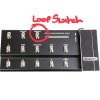Hi, I have a Line 6 FBV MkII shortboard that has a number of footswitches to control the various patches. One of them turns a looper on and off but it is in a really difficult position to use so I’d like to move it to an external switch.
The switch is a 6mm tactile - This one.
Would it be possible to solder a wire to the existing solder points under the switch and then to the underside of a new switch in an external unit?
Thanks for your help.
Pete
The switch is a 6mm tactile - This one.
Would it be possible to solder a wire to the existing solder points under the switch and then to the underside of a new switch in an external unit?
Thanks for your help.
Pete





